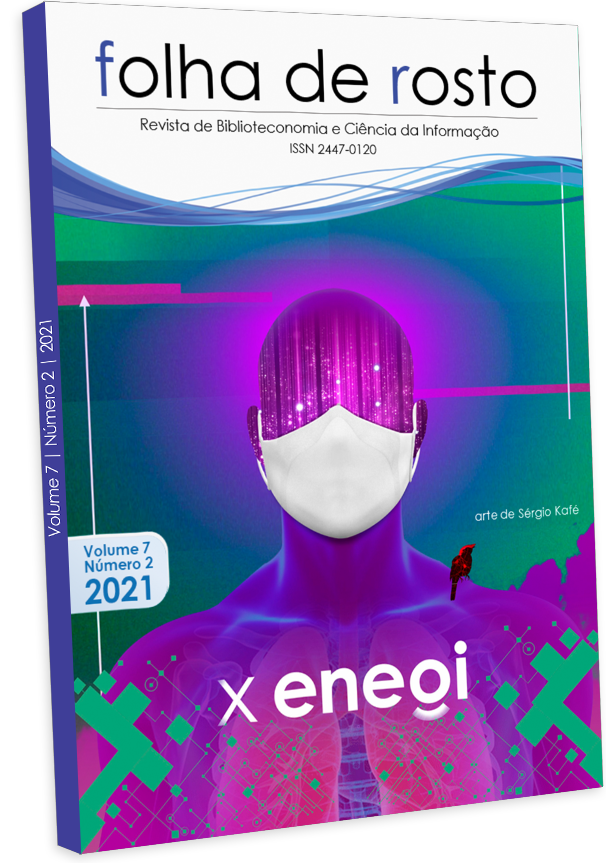An analysis of the Saúde sem Fake News program based on data analytics
Abstract
The circulation of fake news has become one of the biggest challenges in the field of communication, under the most varied aspects, this being directly linked to the advent and accessibility to information and communication technologies. Authorities have made efforts in actions that seek to face this problem, through, for example, the development of projects that promote social awareness. At the Covid-19 pandemic scenario, the circulation of fake news becomes a problem that demands greater attention. This article proposes to carry out an analytical study, through the application of data analysis, to understand the panorama of fakes news in the health area, based on analyzes carried out with the publications published by the Saúde sem Fake News project, from the Brazilian Ministry of Health.
References
AMARAL, F. Aprenda Mineração de Dados: teoria e prática. Rio de Janeiro: Alta Books, 2016.
ALLCOTT, H.; GENTZKOW, M. Social media and fake news in the 2016 election. Journal of Economic Perspectives, v. 31, n. 2, p. 211–236, 2017.
APS, L.R.M.M.; PIANTOLA, M.A.F.; PEREIRA, S.A.; CASTRO, J.T.; SANTOS, F.A.O.; FERREIRA, L.C.S. Eventos adversos de vacinas e as consequências da não vacinação: uma análise crítica. Rev. Saúde Pública, v. 52, n. 40, p. 1-13, 2018.
BAKIR, V.; MCSTAY, A. Fake news and the economy of emotions: Problems, causes, solutions. Digital Journalism, v. 6, n. 2, p. 154–175, 2017.
CONFORTO, D.; CAVEDINI, P.; MIRANDA, R.; CAETANO, S. Pensamento computacional na educação básica: interface tecnológica na construção de competências do século xxi. RBECM, v. 1, n. 1, p. 99-112, 2018.
D’ANCONA, M. Pós-verdade: a nova guerra contra os fatos em tempos de fake news. Barueri, São Paulo: Faro Editorial, 2018.
ESCOLA NACIONAL DE SAÚDE PÚBLICA SERGIO AROUCA (ENSP). Brasil recebe certificado de eliminação do sarampo. Disponível em: http://informe.ensp.fiocruz.br/noticias/40569. Acessado em: 14 de nov. 2020.
KAKUTANI, M. A morte da verdade: notas sobre a mentira na era Trump. Rio de Janeiro:Intrínseca, 2018.
LÉVY, P. As tecnologias da inteligência: o futuro do pensamento na era da informática. [S.l.]: Editora 34, 1993.
LIMA, C.R.M.; SÁNCHEZ-TARRAGÓ, N.; MORAES, D.; GRINGS, L. Emergência de saúde pública global por pandemia de Covid-19: desinformação, assimetria de informações e validação discursiva. Folha de Rosto, v. 6, n. 2, p. 5-21, 2020.
MARTINO, L.M.S. Teoria das mídias digitais: linguagens, ambientes, redes. Rio de Janeiro: Vozes, 2014.
MITCHELL, R. Web Scraping com Python. São Paulo: Novatec, 2015.
O’REILLY, T. What Is Web 2.0 - Design Patterns and Business Models for the Next Gene-ration of Software. [S.l.]: O’Reilly Publishing, 2005.
PROVOST, F.; FAWCETT, T. Data Science para Negócios. Rio de Janeiro: Alta Books, 2016.
RAMONET, I. A explosão do jornalismo na era digital. In: MORAES, D.; RAMONET, I.; SERRANO, P. (Org.). Mídia, poder e contrapoder: da concentração monopólica à democratização da informação. São Paulo: Boitempo, 2013.
RISTOSKI, P.; PAULHEIM, H. Semantic web in data mining and knowledge discovery: a comprehensive survey. Journal of Web Semantics, Elsevier, v. 36, p. 1–22, 2016.
SERRANO, P. Outro jornalismo possível na Internet. In: MORAES, D.; RAMONET, I.; SERRANO, P. Mídia, poder e contrapoder: da concentração monopólica à democratização da informação. São Paulo: Boitempo Editorial, 2013. p. 145-182.
TEIXEIRA, J. F.; MARTINS, A. V. Fact-checking no combate às fake news sobre a COVID-19: um estudo exploratório das agências digitais de checagem de fatos contra a desinformação da pandemia. Comunicação e Informação, v.21 n.47 p.63-81. São Caetano do Sul. 2020.
VERGÈS, P.; BOURICHE, B. L’analyse des données par les graphes des similitude. Sciences Humaines, 2003.
VIEIRA, L. M.; SILVA, N.; CORDEIRO, D. Análise descritiva das fake news da saúde através de mineração de textos no Portal da Saúde. In: Congresso de Ciências da Comunicação na Região Centro Oeste, XXI, Goiânia, 2019. Anais… Goiânia: Intercom, 2020.
VOSOUGHI, S.; ROY, D.; ARAL; S. The spread of true and false news online. Science, 359, 1146–1151 (2018).
WARDLE, C. Information disorder: toward an interdisciplinary framework for research and policy making. Strasbourg: Council of Europe, 2017.
WHO. WHO characterizes COVID-19 as a pandemic. World Heal. Organ, 2020. Disponível em: https://www.paho.org/hq/index.php?option=com_content&view=article&id=15756:who-characterizes-covid-19-as-a-pandemic&Itemid=1926&lang=en. Acesso em: 13 nov. 2020.
ZHOW, L.; ZHENHUA, X.; CASTIGLIONE, G. M.; SOIBERMAN, U. S.; EBERHART, C. G.; DUH, E. J. ACE2 and TMPRSS2 are expressed on the human ocular surface, suggesting susceptibility to SARS-CoV-2 infection. BioRxiv, 2020. Disponível em https://www.biorxiv.org/content/10.1101/2020.05.09.086165v1. Acesso em :13 nov. 2020.
Copyright (c) 2021 Folha de Rosto

This work is licensed under a Creative Commons Attribution-NonCommercial-NoDerivatives 4.0 International License.
Ao encaminhar textos à revista, o autor estará cedendo integralmente seus direitos patrimoniais da obra à publicação, permanecendo detentor de seus direitos morais (autoria e identificação na obra), conforme estabelece a legislação específica.
O trabalho publicado é considerado colaboração, portanto, o autor não será cobrado pela publicação ou receberá nenhum tipo de pagamento ou pró-labore.
Os textos são de responsabilidade de seus autores. Citações e transcrições serão permitidas mediante menção às fontes.








